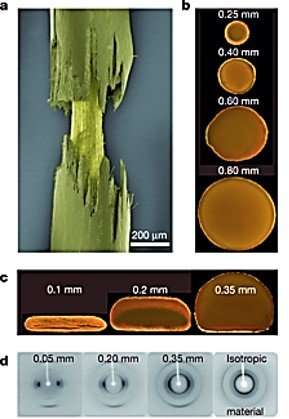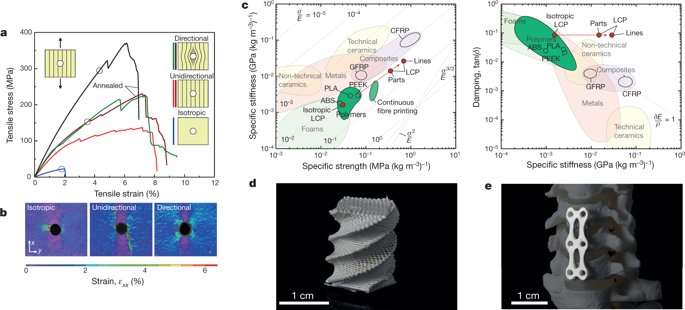October 9, 2018 feature
3-D printing hierarchical liquid-crystal-polymer structures
![Printing hierarchical thermotropic LCPs using fused deposition modeling. a) short rod-like polymer chains formed by an aromatic random copolymer consisting of the rigid monomers p-hydroxybenzoic acid and 2-hydroxy-6-napththoic acid, b) the rigid and imperfectly oriented polymer rods align along the same director n in the melt, misaligning θ towards the director to form a nematically ordered domain, c) the quasi-isotropic bulk of the polymer was formed via locally aligned nematic domains with randomly oriented directors, d) during extrusion through the heated nozzle (at temperature TN with diameter dN), the directors were subjected to shear forces of elongation that can rearrange polymers in the melt and align the directors along the direction of extrusion, e) once extruded, the material began to lose its orientation at the same time the solidification front froze the nematic order to place, starting from the surface. The resultant effects formed a core-shell structure with a highly aligned shell of thickness λN, f) depositing material on a surface at height h promoted further alignment of the director in the print direction to form a core-shall structure with different skin thickness due to distinct cooling rates for air, glass and polymer substrate. [THB: temperature of the heated bed/substrate; TRT: temperature of the environment (room temperature); VE: velocity of extrusion; VP: printing velocity; w: print width; λA: thickness of skin aligned to air; λH: thickness of skin aligned to the heated bed/substrate], g,h) the chain ends can cross-link chemically via thermal annealing to increase the molecular weight stress transfer between filaments. Credit: Nature Letter doi:10.1038/s41586-018-0474-7. 3-D printing hierarchical liquid-crystal-polymer structures](https://scx1.b-cdn.net/csz/news/800a/2018/3dprintinghi.jpg)
Biological materials from bone to spider-silk and wood are lightweight fibre composites arranged in a complex hierarchical structure, formed by directed self-assembly to demonstrate outstanding mechanical properties.
When such bioinspired stiff and lightweight materials are typically developed for applications in aircraft, automobiles and biomedical implants, their manufacture requires energy and labor-intensive fabrication processes. The manufactured materials also exhibit brittle fracture characteristics with difficulty to shape and recycle, in stark contrast to the mechanical properties of nature. Existing polymer-based lightweight structure fabrication is limited to 3-D printing, with poor mechanical strength and orientation, while highly oriented stiff polymers are restricted to construct simple geometries. In an effort to combine the freedom of structural shaping with molecular orientation, 3-D printing of liquid-crystal polymers was recently exploited. Although desirable shape-morphing effects were attained, the Young's modulus of the soft elastomers were lower than high-performance liquid-crystal synthetic fibers due to their molecular structure.
To fully exploit the shaping freedom of 3-D printing and favorable mechanical properties of molecularly oriented liquid-crystal polymers (LCP), a team of scientists at the Department of Materials, ETH Zürich, proposed a novel approach. The strategy followed two design principles that are used in nature to form tough biological materials. Initially, anisotropy was achieved in the printing process via self-assembly of the LCP ink along the print path. Thereafter, complex-shaping capacity offered by the 3-D printing process was exploited to tailor the local stiffness and strength of the structure based on environmental loading conditions. In the study, Silvan Gantenbein and co-workers demonstrated an approach to generate 3-D lightweight, recyclable structures with hierarchical architecture and complex geometries for unprecedented stiffness and toughness. The results are now published in Nature.
Features of the novel material arose from the self-assembly of liquid-crystal polymer molecules into highly oriented domains – achieved during extrusion of the feedstock material. Orienting the molecular domains with the print path reinforced the polymer structure to meet the expected mechanical stresses. The results led to the development of materials with strength and toughness that outperformed state-of-the-art 3-D printed polymers, comparable with the highest performance lightweight composites hitherto constructed. The study demonstrated the ability to combine top-down 3-D printing with bottom-up molecular control of polymer orientation, opening the possibility to freely design and fabricate structures that circumvented typical restrictions of the existing manufacturing process.
By structure, the rigid molecular segments of aromatic thermotropic polyesters could self-assemble into nematic domains at temperatures higher than the material's melting temperature. Polymer melt extrusion through the 3-D printer nozzle gave rise to shear and extension flow fields that aligned the nematic domains in the direction of flow. A temperature gradient subsequently formed between the cold surface of the filament and its hot interior for rapid cooling at the surface, causing solidification in the flow-aligned arrangement. Polymer chains present in the interior of the filament experienced slower cooling to re-orient, driven by thermal motion. As a result, the extruded filaments possessed a core-shell structure in which a highly aligned skin enclosed a less oriented core. The thickness of the skin relied on the diameter of the filament and the operating temperature.

The effect of the printing parameters on the final core-shell architecture was decided using a simple analytical heat-transfer model. The authors used optical microscopy and X-ray scattering experiments to confirm the highly aligned skin structure. The core-shell filaments demonstrated significant mechanical strength and elastic modulus, in contrast to previous studies that used fused deposition modeling (FDM). The Young's modulus of the material relied on the production of filaments thinner than the nozzle diameter for effectively improved stiffness and strength of the printed materials. Additional factors including the manufacturing temperature, layer height, molecular crosslinks and annealing time affected the Young's modulus of the printed materials.
The scientists observed multiple stress peaks for stress-strain measurements during materials characterization that resembled toughening mechanisms of biological materials such as bone. This was credited to the thermal treatment process to enhance crosslinks between the filaments for stress transfer; preventing delamination through crack-arresting mechanisms. The high toughness of the annealed laminates was thought to emerge from hierarchical cross-linking of macromolecules and filaments.
The material construction enabled self-assembly and hierarchical macromolecular cross-linking strategies via layer-by-layer additive manufacture to replicate bioinspired design principles. High-performance laminates with higher strength and Young's modulus without damping loss were achieved by tuning the fibre orientation to best match the stress lines throughout the mechanically loaded structure. The ensuing product demonstrated characteristics unprecedented in lightweight materials.

The printed LCPs surpassed existing material types including reinforced polymers and continuous fibre-printed composites to match the stiffness and strength of carbon fibre-reinforced polymers. Additional features of the process included recyclability, automated manufacturing and lower carbon footprint. The 3-D printing techniques and the proposed additive technology allowed the production of application-specific complex geometries. The authors envision that it will be possible to achieve unparalleled levels of hierarchical structural complexity for lightweight materials by combining 3-D printing-based path control, alongside tunable orientation of self-assembled building blocks in the ink. The strategy opens up the possibility of fabricating structures that can fulfill diverse requirements as a sustainable material with a circular life.
More information: Silvan Gantenbein et al. Three-dimensional printing of hierarchical liquid-crystal-polymer structures, Nature (2018). DOI: 10.1038/s41586-018-0474-7
Raphael Schaller et al. High-performance liquid-crystalline polymer films for monolithic "composites", Composites Part A: Applied Science and Manufacturing (2015). DOI: 10.1016/j.compositesa.2015.11.024
Steven W. Cranford et al. Nonlinear material behaviour of spider silk yields robust webs, Nature (2012). DOI: 10.1038/nature10739
Arda Kotikian et al. 3D Printing of Liquid Crystal Elastomeric Actuators with Spatially Programed Nematic Order, Advanced Materials (2018). DOI: 10.1002/adma.201706164
Ulrike G. K. Wegst et al. Bioinspired structural materials, Nature Materials (2014). DOI: 10.1038/nmat4089
Journal information: Nature , Advanced Materials , Nature Materials
© 2018 Phys.org




















